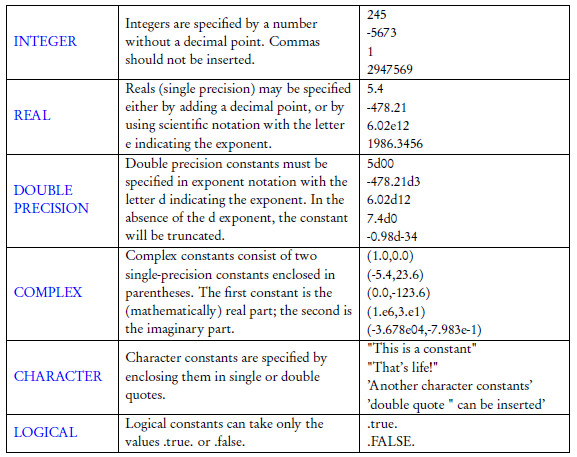Variables and assignment
Variables are the fundamental building blocks of any program. In Fortran, a variable name may consist of up to 31 alphanumeric characters, of which the first character must be a letter. Underscores are allowed but not spaces or special characters.Variable Types
Fortran defines several distinct types corresponding to the generic types described above. These includeINTEGER REAL DOUBLE PRECISION (this name is obsolet but is still widely used) COMPLEX CHARACTER LOGICALConstants are literal representations of a type that are specified by the programmer. In Fortran, different constant formats are required for each type.

The following program illustrates variable declarations.

Characters
Characters can either be declared as a single CHARACTER variable, a string of characters or an array of single characters or character strings.
character :: c1 ! Single character
character(len=80) :: c2 ! String of characters
character, dimension(10) :: c3 ! Array of single
! characters
character(len=80), dimension(10) :: c4 ! Array of character
! strings (10 elements)
Using kind
The current preferred method of specifying the precision of a variable is to use the KIND representation. With KIND, the programmer specifies the number of decimal digits and the exponent range required, and the system matches the request to its underlying machine representation as closely as possible. Since nearly all current systems use the IEEE 754 convention, in practice only two kinds are widely used. Compilers still recognize the REAL and DOUBLE PRECISION keywords. The advantage to the kind convention is that it can be made very simple to switch between real and double precision. For most purposes, it is only necessary to use the SELECTED_REAL_KIND intrinsic and the programmer need never worry about what is going on within the machine. To declare single precision, useINTEGER, PARAMETER:: rk = SELECTED_REAL_KIND(6,37)To declare a double precision, use
INTEGER, PARAMETER :: rk = SELECTED_REAL_KIND(15,307)Quadruple precisions (not very often used):
INTEGER, PARAMETER :: rk = selected_real_kind(33, 4931)Floating-point variables can now be declared with statements such as
REAL (rk) :: r, s, tand the precision will be determined by which selected_real_kind statement precedes the declarations.
Here is a complete example showing how to use selected_real_kind:
program select_kind
implicit none
integer, parameter :: i4=SELECTED_INT_KIND(4)
integer, parameter :: i8=SELECTED_INT_KIND(8)
integer, parameter :: i15=SELECTED_INT_KIND(15)
integer, parameter :: r4=SELECTED_REAL_KIND(6,37)
integer, parameter :: r8=SELECTED_REAL_KIND(15,307)
integer(KIND=i4) :: ia
integer(KIND=i8) :: ib
integer(KIND=i15) :: ic
real(KIND=r4) :: ra
real(KIND=r8) :: rb
print *,' Integer kind=', i4, ' biggest value=', huge(ia)
print *,' Integer kind=', i8, ' biggest value=', huge(ib)
print *,' Integer kind=', i15, ' biggest value=', huge(ic)
print *,' Real kind=', r4, ' smallest value= ', tiny(ra) , &
' biggest value=', huge(ra)
print *,' Real kind=', r8, ' smallest value= ', tiny(rb) , &
' biggest value=', huge(rb)
end program select_kind